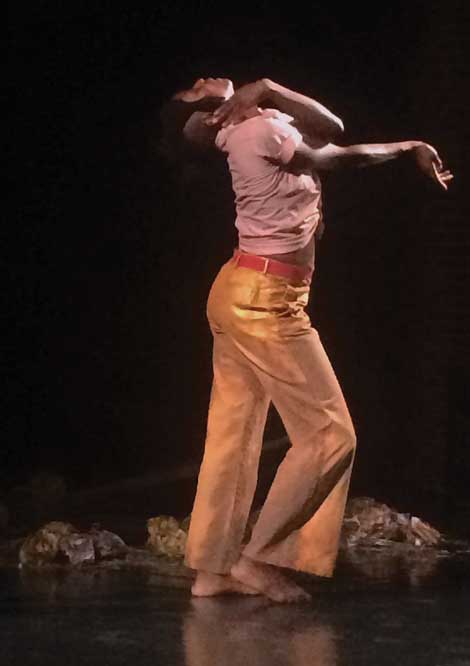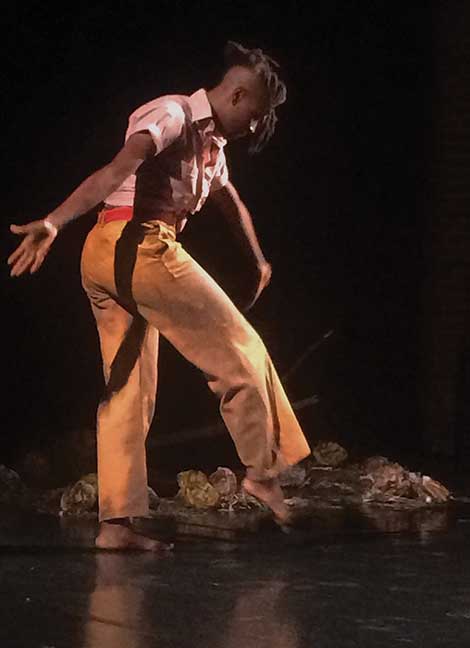Bodies are complicated. Choosing to work with the body as an artistic material complicates its complications. The resulting nest, where taisha paggett settles in to practice, can be thick and sticky. Paggett has grappled with the ways identity and environment are borne by the body from her beginnings in dance as an 18-year-old in her native Fresno, California, a racially segregated agricultural city. Her undergraduate studies at UC Santa Cruz gave rise to her interests in human and spatial geographies and in connecting dance forms with the structures of visual art. “I wasn’t just trying to talk about [the space of] the concert stage, but rather how the dancing body makes meaning—in whatever context,” says paggett (who prefers lower case letters for her name). “And when I got to studying more contemporary performance works, I was able to make really tangible, tactile connections. I think that turned my brain on.”

taisha paggett, Performance at Live Arts Exchange Festival in Meg Wolfe’s dance work-in-progress, New Faithful Disco, Photo by Nancy Popp.
The tentacles of paggett’s work take many shapes, from contemporary dance performances with choreographers Meg Wolfe and David Rousséve to artistic projects with Kelly Nipper, Ashley Hunt, and the collective Ultra-red, as well as solo performances. Most recently, she staged a five-day continuous site-specific intervention, Underwaters (we is ready, we is ready) inside the Whitney Museum as part of the 2014 Whitney Biennial, and performed as part of the Live Arts Exchange Festival in Meg Wolfe’s dance work-in-progress, New Faithful Disco. A full-time Guest Lecturer at the Dance Center of Columbia College, Chicago from 2011–2014, she is now a newly appointed assistant professor in the
Department of Dance at UC Riverside.
For her 2012 exhibition “Let’s Use These Things” at the Los Angeles space Commonwealth and Council, paggett choreographed questions of how bodies relate to the material objects of the world. Through her persona Fila Buster, paggett called forth a character that gave politicized voice to the silenced black body and its history, starting with the rise of the filibuster through the Kansas-Nebraska Act of 1854. The exhibition also included video, installation and a multicolored action painting paggett executed using her hair.
In choosing an MFA program, paggett enrolled in UCLA’s World Arts and Cultures/Dance primarily for its interdisciplinary perspective. Since then she has built her work upon the postmodern Judson Dance interdisciplinary approach of expanding the notions of “what-is-dance” and “what-is-not-dance” farther afield. In highlighting a renewed interest and appreciation for dance merged with visual arts and performance, she investigates the aesthetics of bodies—active bodies, stream-of-consciousness bodies and political bodies. Her interdisciplinary approach is particularly relevant, given that the 50th anniversary of Judson Dance Theater has echoed throughout the art world for the past two years. Yvonne Rainer’s current Getty Museum retrospective and recent co-performances by Simone Forti and Anna Halprin in the Bay Area are but a few of the current re-presentations of Judson Dance, illustrating the Judson focus on a “neutral” body and quotidian gestures as a site for postmodern choreography. Paggett shifts the focus to difference, to being present in the body and negotiating how one is perceived and labeled through it and its political-socio-context as part of a formal embodied practice. The emphasis is on experience more than presentation, a shared experience with the audience, and on the environment that assists both the performer and audience in grappling with questions around identity, character and subjectivity.

taisha paggett_Underwaters (we is ready, we is ready) performance at the Whitney Biennial, April 16th–20th, 2014. Photo by Ashley Hunt and Christopher Golden.
Paggett asserts the black body through her explorations and her prowess. Specifically, she examines the intrinsically human issues of race and power, and what meanings the movements, actions and expressions of a racialized body present. Combined with her political themes, she takes a bold, confrontative, yet graceful stance. In light of recent events in Ferguson, Missouri, the black body is more visible in its history of persecution, while its value is still being undermined. It has yet to be fully counted as a body that matters. Paggett does not move away from confronting these thorny painful nests; rather, she inserts herself head-on into their thickness, as excerpts from her written work vestibular mantra (or radical virtuosities for a brave new dance) articulate:
stay fearless and momentous. stay
unwieldy and excretory. stay oceanic. keep
letting this piece drag on. stay humble.
because we don’t collapse so much as bellow
in and out, collectivity lunging into one another like
an accordion before its next breath, and
in these folds lies the fervor.
stay high-low brow, stay curious, stay rioting,
stay asking tough questions, stay unclassifiable,
stay getting crazy looks.
stay visible, stay wanting more, stay addressing
what’s not there and what the
audience isn’t willing to see.



